
Schlumbergera truncata (Christmas or Holiday Cactus) on 6-9-12, #98-9.
Christmas Cactus, Holiday Cactus, Crab Cactus
Schlumbergera truncata
shlum-BER-ger-uh trunk-AH-tuh
Synonyms of Schlumbergera truncata (23) (Last updated on 12-12-22 from Plants of the World Online): Cactus truncatus (Haw.) Link (1822), Cereus truncatus (Haw.) Sweet (1826), Cereus truncatus var. altensteinii Salm-Dyck (1834), Epiphyllum altensteinii Pfeiff. (1837), Epiphyllum delicatum N.E.Br. (1902), Epiphyllum elegans Cels ex C.F.Först. (1846), Epiphyllum guedneyrii Houllet (1875), Epiphyllum purpurascens Lem. (1841), Epiphyllum ruckeri Paxton (1846), Epiphyllum ruckerianum Lem. (1861), Epiphyllum salmoneum Cels ex K.Schum. (1897), Epiphyllum smithianum Marnock (1840), Epiphyllum truncatum Haw. (1819), Epiphyllum truncatum var. cruentum T.Br. (1864), Epiphyllum truncatum var. magnificum T.Br. (1864), Epiphyllum truncatum var. spectabile T.Br. (1864), Epiphyllum truncatum var. wagneri Rol.-Goss. ex Guillaumin (1932), Epiphyllum violaceum Cels ex C.F.Först. (1846), Schlumbergera truncata var. altensteinii (Pfeiff.) Moran (1953), Schlumbergera truncata var. delicata (N.E.Br.) Moran (1953), Zygocactus altensteinii (Pfeiff.) K.Schum. (1890), Zygocactus delicatus (N.E.Br.) Britton & Rose (1913), Zygocactus truncatus (Haw.) K.Schum. (1890)
Schlumbergera truncata (Haw.) Moran is the correct and accepted name for this plant commonly known as the Christmas or Holiday Cactus. It was named and described as such by Reid Venable Moran in Gentes Herbarum in 1953. It was first named Epiphyllum truncatum and described by Adrian Hardy Haworth in Supplementum Plantarum Succulentarum in 1819.
The genus, Schlumbergera Lem., was named and described by (Antoine) Charles Lemaire in Revue Horticole in 1858.
As of 12-12-22 when this page was last updated, Plants of the World Online lists 7 species of Schlumbergera. It is a member of the plant family Cactaceae with 150 genera. Those numbers could change as updates are made on POWO.
Schlumbergera truncata or its cultivars (Truncata Group) all have the same characteristics that set them apart from other popular species in the genus. Their segments have 2-3 “teeth” or “hooks” along the edges and ends. All species of Schlumbergera have leafless stems which are called cladodes. Cladodes are modified stems used for photosynthesis. Schlumbergera truncata can flower anywhere from mid-October through December in the United States which is triggered by decreasing day length and temperature. They flower in May in their native habitat in southern Brazil. Their flowers sort of sit more or less in a horizontal position and they have yellow pollen. This species is commonly referred to as the Thanksgiving Cactus because it supposedly flowers earlier than S. russelliana. This completely depends on light and temperature.
According to information online, Schlumbergera russelliana and its cultivars generally flower around the same time as Schlumbergera truncata but may not flower as early. I am not 100% sure because at the time I am writing this I have not grown this species. I am working on it… Crosses between Schlumbergera truncata and S. russelliana are also popular and are generally referred to as x buckleyi hybrids (The Buckleyi Group). Plants of this species, its cultivars, and the hybrids have scalloped edges on the segments with NO “teeth” or “hooks”. Their flowers look similar to S. truncata but they hang downwards and they have pink pollen. This species has nine synonyms including Schlumbergera bridgesii which is a name it is commonly under. This species is commonly referred to as the Christmas Cactus because they supposedly flower later than S. truncata. Again, that depends on light and temperature… I will know more when I get “at least” one. 🙂
I acquired a pot with three cuttings of Rhipsalidopsis gaertneri which is known as the Easter Cactus. Actually, it is the genuine Easter Cactus. They are also from southern Brazil. Their segments are thicker than S. truncata and russelliana and are scalloped with NO “teeth” or “hooks”. Its flowers are MUCH different and they flower around the Easter holiday… I do have a page for this one which you can view by clicking on its name.
Schlumbergera truncata and S. russelliana (and their cultivars and hybrids) can be forced to flower in the spring. Some companies do this and sell them as Easter Cactus. The Wikipedia page for the genus (see link at the bottom of the page) has a lot of useful information.
There are a few links at the bottom of the page for further reading.

Schlumbergera truncata in bloom on 12-9-12, #135-2.
When I was living in Leland, Mississippi, one of my neighbors gave me this cactus in 2012. We had gotten acquainted because she had a really nice yard with lots of flowers. We also traded a few plants now and then.
Flowering is triggered by a combination of temperature and darkness. Naturally, the day length decreases as cooler temperatures come in the fall. Both are important to trigger buds to develop. Night temperatures between 55-65° F and around 12-13 hours of darkness is ideal. If temperatures rise above 90° F the buds could fall off.

Schlumbergera truncata flower on 12-9-12, #135-3.
This plant is tolerant of dry conditions and should not be over-watered, especially during the winter. Information online says to water when the soil is dry to the touch but should not be allowed to dry completely out. Watering should also be decreased during the winter months. I can positively tell you my Schlumbergera has completely dried out MANY times. Their leaves shrivel a little but always perk back up when I give them water.
I gave this cactus to a friend when I moved from Mississippi back to the family farm in Missouri in 2013.
<<<<2019>>>>

Schlumbergera truncata from Wagler’s after I brought it home on 9-13-19, #507-15.
I went to Wager’s Greenhouse on September 13 (2019) to take a few cuttings of Stapelia gigantea. We trade plants off and on. Anyway, I looked around and saw she had a nice selection of Schlumbergera truncata. I had not brought any home from anywhere until now because I didn’t want one with pink flowers. Wagler’s had a selection of pink, white, orange, and peach so I decided to bring home a peach… None of them were flowering, so I was taking a chance.

Schlumbergera truncata on 10-10-19, #519-61.
I had to move the potted plants inside for the winter on October 10 because an “F” was in the forecast. The Schlumbergera truncata had already grown quite a bit.

Schlumbergera truncata with a few buds on 11-11-19, #648-7.
I had the Schlumbergera truncata in my bedroom for a while but thought it would do better in the kitchen windowsill. Next thing I knew there were a few buds.

Schlumbergera truncata on 11-18-19, #653-5.
Hmmm… It doesn’t look like peach to me.

Schlumbergera truncata flowers on 11-22-19, #654-5.
Well, as you can see, this is pink and not peach. I went back out to Wagler’s to see if they had any peach or white left and there was none. She had gotten several shipments in but she said this man kept buying most of them so she didn’t have any left. I told her the one I bought that was supposed to be peach turned out pink. Someone must have put the wrong label in this pot or they got mixed up somehow.
Even though their main growing period is between April and September, this one has grown A LOT since it flowered.
<<<<2020>>>>

Schlumbergera truncata (Holiday Cactus) starting to flower on 11-9-20, #756-1.
The Schlumbergera truncata had been outside during the summer and grew pretty well. I had to bring the potted plants inside for the winter on October 15 (2020) because an “F” was in the forecast. I put it back on the kitchen windowsill because it had done very well there before. Not long after that, it started budding…

Schlumbergera truncata (Holiday Cactus flower on 11-9-20, #566-2.
The flowers are always very neat in how they emerge from the tip of the last segment, the same place a new segment grows from.

Schlumbergera truncata (Holiday Cactus) flower on 11-9-20, #566-3.
NICE!

Schlumbergera truncata (Holiday Cactus), the new red one, on 11-9-20, #566-4.
One day when I went to Wagler’s they had a few more of these plants. I checked the tags and found a nice one that said it would be red… Over the summer, this plant’s leaves turned a purplish maroon. I thought there were a few buds but they either fell off or turned out to be new segments. No flowers…

Schlumbergera truncata (Holiday Cactus) flowering on 11-9-20, #759-1.
By November 9, the pink one seemed to be in full swing. I moved it to the new plant shelf I made for my bedroom.

Schlumbergera truncata (Holiday Cactus), the red one, on 11-15-20, #759-2.
The red one was still doing well on the kitchen windowsill but it seemed kind of lonely…

Schlumbergera truncata (Holiday Cactus) on 11-15-20, #759-3.
SO, I moved it to the bedroom as well.

Schlumbergera truncata (Holiday Cactus) on 11-15-20, #759-4.
The pink one has really grown and is sending out new branches right and left…
Schlumbergera species have leafless stems called cladodes that act as photosynthetic organs. The cladodes are made up of flat segments that have 2-3 teeth along their edges and ends. The species gets its scientific name, “truncata” from the word “truncated” meaning “cut off” or “abruptly cut off” because the tips look cut off rather than being round or pointed. The areola between the two teeth on the ends have brown wool and bristles and is where the flowers and new segments appear.

Schlumbergera truncata (Holiday Cactus) on 11-15-20, #759-5.
I never noticed the brown wool before, but the red one is quite wooly between the teeth at the tip. The red one also has darker segments and over the summer the whole plant was a shade of reddish-brown. Now it has these weird little aerial roots.
THEN, ON NOVEMBER 18…

Three new Schlumbergera from Wagler’s Greenhouse after I brought them home on 11-17-20. A red and yellow Schlumbergera truncata in the back and a Rhipsalidopsis gaertneri (Easter Cactus) in the front. #760-1.
I went to Wagler’s Greenhouse on November 17 to see if she had any Schlumbergera truncata available. I thought she may have already sold out but I was hoping to find a peach color. To my surprise, she had quite a selection of red, yellow, and pink but NO peach. I decided I would get another red one since mine wasn’t going to flower and I also picked out a yellow one. Then she told me she had an Easter Cactus that had red flowers but she said they were not like the Christmas Cactus. She said she had taken a few cuttings and I could have one if I wanted it. She took me back to where it was and it was definitely different even without flowers… She didn’t have very many so I was glad she offered to give me one. I had previously done some research about the species and when I saw them I knew they were genuine Rhipsalidopsis gaertneri, even if I didn’t remember the name right off, a for-real Easter Cactus. Some companies force Schlumbergera truncata to flower during easter and sell than as Easter Cactus. I wrote a page for the Rhipsalidopsis gaertneri which you can view by clicking HERE.
My pink Schlumbergera truncata flowered earlier than hers because it was moved inside in much less light, which triggered it to flower. Hers are greenhouse grown so they rely on naturally decreasing daylength to flower. Even so, she said they were flowering earlier than last year. I told her mine was about 2 weeks earlier than in 2019.

Schlumbergera truncata, the yellow-flowered pot, on 11-17-20, #760-2.
Mrs. Wagler said the yellow isn’t that bright, more like a creamy color.

Schlumbergera truncata (Holiday Cactus), the red-flowered pot, on 11-17-20, #760-3.
She also said the red wasn’t a deep red. More of a dark pink… Hmmm…

Close-up of the S. truncata yellow buds on 11-18-20, #761-8.
I decided to get a few close-ups on November 18… The above is a close-up of the buds on the yellow-flowered plant.

Schlumbergera truncata, yellow-flowered plant, on 11-18-20, #761-9.
The above photo shows a smaller bud on the yellow-flowered plant sharing the same areola as a new segment.

Schlumbergera truncata, close-up of the red buds, on 11-18-20, #761-10.
Above is a close-up of a bud on the red-flowered Schlumbergera truncata.

Schlumbergera truncata, red-flowered, on 11-18-20, #761-11.
Above is a close-up of the areola of a segment of the red-flowered Schlumbergera truncata. Notice it also has more bristles…

Schlumbergera truncata, yellow-flowered on 11-23-20, #762-1.
Monday morning, the 23rd, I was greeted with a flower when I went to make my coffee.

Schlumbergera truncata, yellow-flowered on 11-23-20, #762-2.
I think what made it so special was that it wasn’t pink. It’s a guy thing and pink seems girly. 🙂

Schlumbergera truncata, yellow-flowered on 11-23-20, #762-3.
Well, I have two more close-ups of the flower but you might be wondering how many more of the same flower I am going to upload. 🙂

Schlumbergera truncata, yellow-flowered on 11-23-20, #762-4.
But, you have to admit…

Schlumbergera truncata, yellow-flowered on 11-23-20, #762-5.
It is pretty AWESOME!

Schlumbergera truncata, red-flowered on 11-23-20, #762-6.
The bud on the red-flowered plant is just about to open…
The Schlumbergera gaertneri (Easter Cactus) has its own page which you can check out by clicking on the name… You might find it online under the name Hatiora gaertneri… The genus name has changed.

Schlumbergera truncata on 11-25-20, #763-1.
Now, isn’t that something! The morning of the 25th the red one opened up and it appears to be bi-color. 🙂

Schlumbergera truncata on 11-25-20, #763-2.
NICE!!!

Schlumbergera truncata on 11-25-20, #763-3.
Typical Schlumbergera truncata with yellow pollen

Schlumbergera truncata on 11-25-20, #763-4.
This is the one with yellow flowers…

Schlumbergera truncata on 11-25-20, #763-5.
Well, the base of the flowers is sure a lot different than wildflowers. 🙂

Schlumbergera truncata on 11-25-20, #763-6.
Somewhere at the base of the floral tube, where the flower emerges from the areola of the segment, is where the ovaries are. At that point where the ovary is, with Schlumbergera truncata, the floral tube bends upward. I think it is where the first set of petals are. After that point, the flower bends downward somewhat but it still held more or less horizontally. With S. russelliana and the x buckleyi hybrids, the floral tube bends downward at the point where the ovaries are.
Pollinating Schlumbergera is pretty simple since all the necessary parts are right out in the open. All you have to do is rub the pollen from the flowers of one plant on the stigma of flowers from another plant. The stigma is somewhat sticky. You can cross-breed S. truncata with S. russelliana very easily which is how the x buckleyi hybrids came about.
IT WORKED! WE HAVE FRUIT!!!
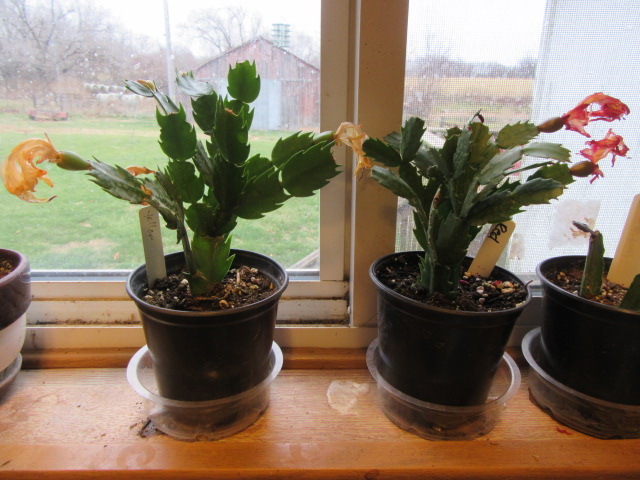
Schlumbergera truncata (Holiday cactus) on 12-13-20, #770-1.
The Schlumbergera truncata are doing very well on the kitchen windowsill. I have been watching them for signs that the hand-pollinating experiment worked…

Schlumbergera truncata (Holiday Cactus), the yellow-flowered plant, 12-13-20, # 770-2.
As the flowers started wilting I started watching and waiting to see what would happen next. As the days passed by, I could see that something a little different was going on with the wilted flowers. The flowers I hadn’t pollinated just fell off but the ones I did remain on the plants.

Schlumbergera truncata (Holiday Cactus), the yellow-flowered plant, 12-13-20, # 770-3.
The next thing I knew, a small swelling appeared which continued to get larger. WE HAVE FRUIT!!!

Schlumbergera truncata (Holiday Cactus), the red-flowered plant, 12-13-20, # 770-4.
The two flowers I hand-pollinated on the red-flowered plant did the same…
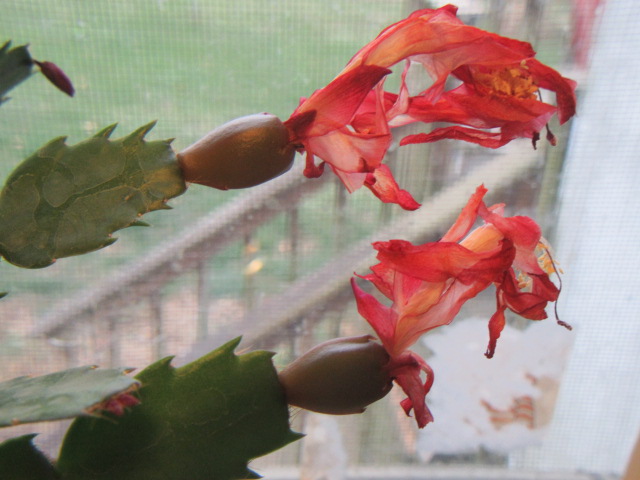
Schlumbergera truncata (Holiday Cactus), the red-flowered plant, 12-13-20, # 770-5.
Now I have to wait for a year before I can remove the fruit and seed to see if they will germinate. Just an experiment…
I can see collecting the different species and colors of Schlumbergera is going to be addictive…
<<<<2021>>>>

Schlumbergera truncata, the yellow-flowered plant, on 2-23-21, #782-3.
The Schlumbergera truncata on the kitchen windowsill has been doing very well over the winter. The fruit has been steadily growing on both the pink and red-flowered plants. Strange things happen sometimes when we least expect it… One day I noticed the yellow-flowered plant had a couple buds.

Schlumbergera truncata (Holiday (Cactus) on 2-23-21, #782-4.
Hmmm… Mid-February was kind of rough with miserable cold, snowy, and cloudy days. I suppose the cloudy days triggered the pink-flowered plant to bud. The red-flowered plant didn’t do it and neither did the Schlumbergera in my bedroom. I decided to move the plants from the bedroom to the kitchen windowsill to get more light and see what happens. Remember, I mentioned before that lowering the light and temperature will trigger them to bud any time of the year. The kitchen is also cooler than my bedroom…

Schlumbergera truncata (Holiday Cactus) on 2-26-21, #783-1.
On February 26, one of the flowers on the yellow plant had opened…

Schlumbergera truncata (Holiday Cactus) on 2-26-21, #783-2.
For me, this is a first for a Schlumbergera truncata to flower in February…

Schlumbergera truncata (Holiday Cactus) on 2-26-21, #783-3.
Right next to one of the fruits from the hand-pollinating experiment…

Schlumbergera truncata (Holiday Cactus) on 2-26-21, #783-4.
I also noticed the red-flowered plant has tiny buds…
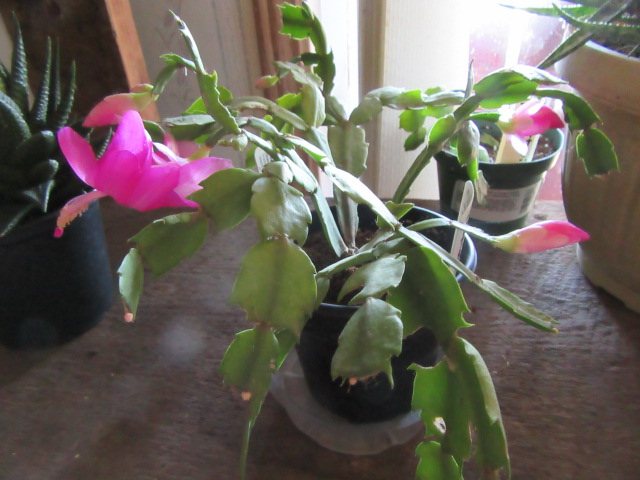
Schlumbergera truncata (Holiday Cactus) on 11-18-21, #856-1.
I kept the Schlumbergera truncata in the kitchen windowsill over the summer except for one that was on the front porch. Then when I moved the plants inside for the winter, I think I put the one that was on the front porch on a shelf in front of the sliding door. Anyway, the plant on the shelf started to bud while the others didn’t… Then, on November 18, the flowers started to open.
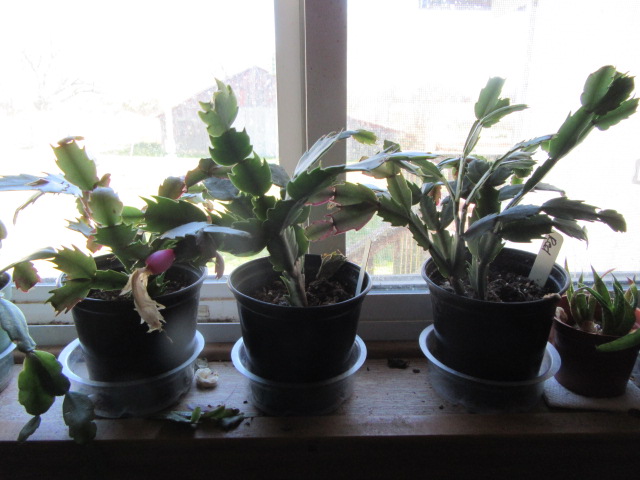
Schlumbergera truncata (Holiday Cactus) on 11-18-21, #856-2.
As you can see, the three Schlumbergera truncata in the windowsill have done nothing… Only one fruit out of the four was still holding on…

Schlumbergera truncata (Holiday Cactus) on 11-30-21, #857-1.
The local Dollar General got in a shipment of Schlumbergera truncata the end of November. I hesitated to even look at them. After a few days, their buds were getting bigger so I had to take a look. By that time, half of them had already been bought. I looked them over and found one that looked like it might have white flowers. Since I didn’t have a white one… Well, I decided to bring it home. What can I say.

Schlumbergera truncata (Holiday Cactus) on 11-30-21, #857-2.
Many of the plants on display had MULTIPLE buds on the ends of their segments. When I say many, I mean probably 6-8.

Schlumbergera truncata (Holiday Cactus) on 11-30-21, #857-3.
One of the segments on the plant I brought home had a good-sized bud plus six smaller buds.

Schlumbergera truncata (Holiday Cactus) on 11-30-21, #857-4.
The plant was wrapped up in a sleeve and when I removed it I noticed several segments had fallen off… They all had multiple buds.
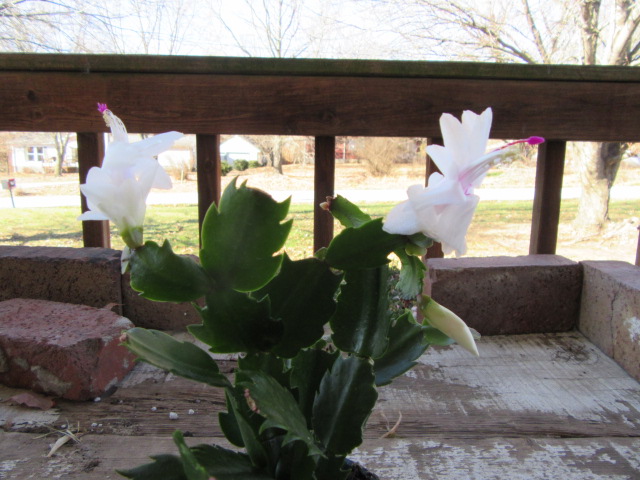
Schlumbergera truncata (Holiday Cactus) on 12-11-21, #858-1.
On December 11, the flowers had opened enough to get some good photos. For sure, it has white flowers…
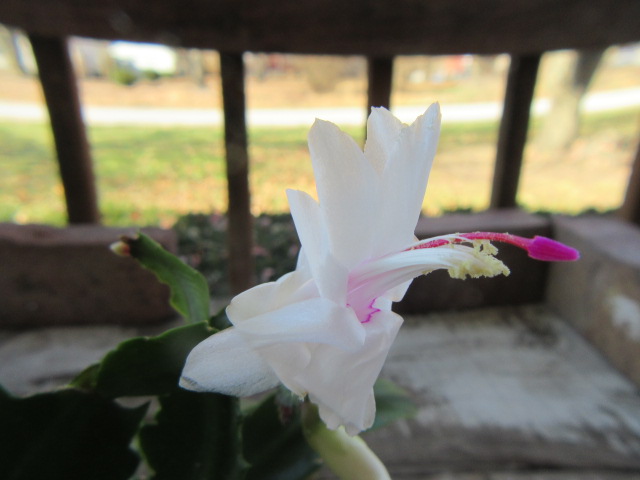
Schlumbergera truncata (Holiday Cactus) on 12-11-21, #858-2.
The lower petals were really reflexed…
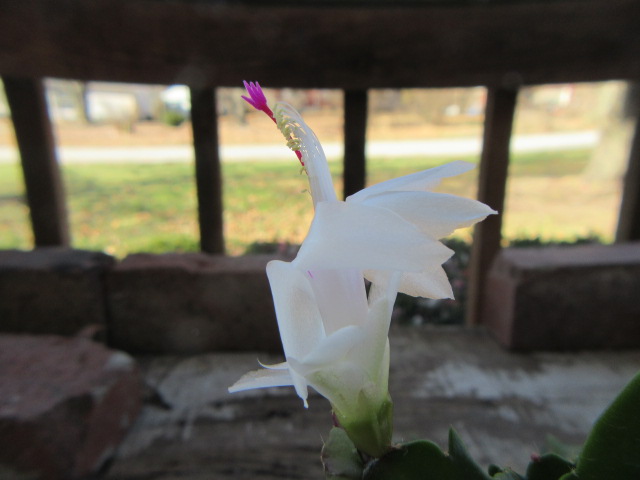
Schlumbergera truncata (Holiday Cactus) on 12-11-21, #858-3.
I think the flower will get longer after a few days…
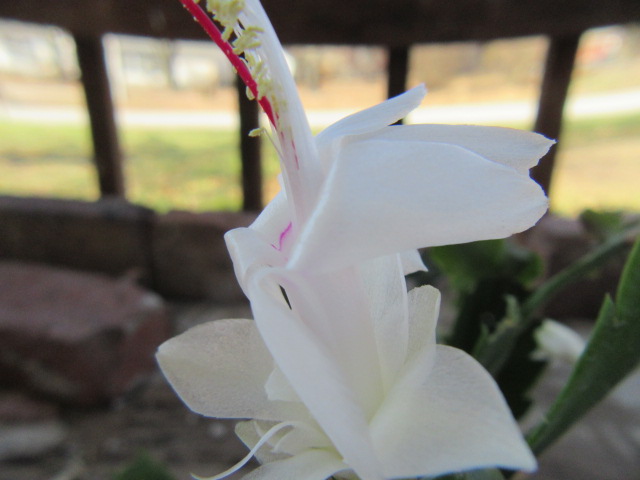
Schlumbergera truncata (Holiday Cactus) on 12-11-21, #858-4.
USEFUL INFORMATION:
Family: Cactaceae
Origin: Southeastern Brazil
Zones: USDA Zones 10b-11 (35 to 40° F)
Size: 12-24” or thereabouts…
Light: Light to part shade. Never in full sun.
Soil: Well-drained potting soil. These plants grow in trees and on rocks in their native habitat so they may prefer a mix similar to other epiphytic plants such as bromeliads and orchids. A 50/50 mix of Miracle Grow Potting Soil and Pumice (or perlite and chicken grit) would be great which is what I use. You can find pumice online at General Pumice
Water: Water when soil is almost dry. Prefers consistently damp soil, not wet. Water less during the winter
*Light: Schlumbergera should not be grown in full sun. Light to part shade is what they need. Remember, they grow in trees in their native environment.
**Soil: Basically, Schlumbergera will grow in just about any type of good potting soil with sphagnum moss (like most do). There are a lot of different recommendations online. Most recommend a potting soil similar to what is used for orchids, bromeliads, or other epiphytic plants. I normally just use Miracle Grow Potting soil amended with pumice (50/50). Most commercial greenhouses just use commercial potting soil. There are a lot of good videos on YouTube about growing Schlumbergera and some have some interesting tips about the growing medium they use.
***Water: Regular watering during the summer, allowing soil to dry between waterings. Some sites say not to let the soil completely dry out. During flowering, you will want to keep the soil moist but not wet. After flowering, some advise to hold off on watering for a couple of months. Never let your Schlumbergera sit in a saucer (under the pot) in water.
Flowering: Decreasing day length and temperature trigger flowering. Once they start to bud and flower, it is recommended NOT to move them because it could cause their flowers to drop off. Been there, done that.
Propagation: Easily propagated by stem cuttings.
I can honestly tell you I have let my Schlumbergera truncata potting soil get dry multiple times with seemingly no ill effects. BUT, if it is done repeatedly, they won’t grow properly and will loose their segments. I know because I think that is my problem. I get busy when they are outside during the summer then next thing I know they are all droopy and weird. I give them water then they perk back up. It isn’t good for them, though, and won’t flower well.
If you want to go to the page for Schlumbergera russelliana and Schlumbergera gaertneri, click on their names.
2023 UPDATE: The Schlumbergera truncata have been doing OK, but they could be better. I am going to switch to potting soil for orchids or make a mix of my own very soon. I am going to try to follow the rules…
I will continue adding more photos and information as time goes by. There is plenty online about growing Schlumbergera as well as many videos on YouTube. They are not hard to grow and only have a few basic rules to follow.
I hope you enjoyed this page and maybe found it useful. If you have any comments, questions, or suggestions, I would like to hear from you. Please click on “like” if you visited this page. It helps us bloggers stay motivated. 🙂 You can check out the links below for further reading. The links take you directly to the genus and species of this plant.